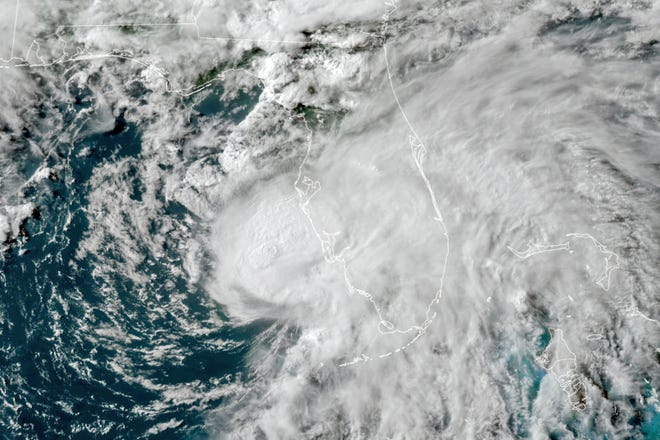
- A hurricane warning was issued for parts of Florida's West Coast.
- "Life-threatening" storm surges, flooding and isolated tornadoes are possible.
- Isolated areas of Florida could see up to 15 inches of rain.
VERO BEACH, Fla. — More than 4 million people were under warnings along Florida's west coast Tuesday as Elsa strengthened again into a hurricane, spinning past the Key West and closer to the Sunshine State.
The hurricane warning was in effect from Egmont Key to the Steinhatchee River. A hurricane warning means that hurricane conditions are expected in the area, in this case within the next 24 hours, according to the National Hurricane Center.
"Preparations to protect life and property should be rushed to completion," the hurricane center said.
The storm was centered about 100 miles south-southwest of Tampa, as of 8 p.m. EDT Tuesday, driving sustained winds of 75 mph, the National Hurricane Center said in an advisory.
The storm moved north at 10 mph, much slower than its record-setting pace of more than 30 mph last week.

Tropical-storm-force winds extended outward up to 90 miles from its center. Earlier Tuesday, the Key West International Airport measured a wind gust of 70 mph.
Fif people were rescued off the coast of Key West, the U.S. Coast Guard said on Twitter. Nine people were still missing as of Tuesday night.
Strong wind gusts and heavy rains swept across parts of southern Florida on Tuesday morning. "Life-threatening" storm surge, flooding and isolated tornadoes were possible, the advisory warned. Much of the southern portion of Florida was under a tornado watch.
The NWS forecast Elsa to make landfall north of Tampa early Wednesday morning. Tampa International Airport planned to shut down Tuesday at 5 p.m.
Isolated pockets could see up to 9 inches, though most places across the Keys would see 3 to 6 inches, the advisory said.
Cubans flee: 180,000 Cubans flee their homes as Tropical Storm Elsa slams ashore
Gov. Ron DeSantis issued a state of emergency for more than two dozen of the state's 67 counties. At a news briefing Tuesday morning, DeSantis reminded residents not to focus on Elsa’s “cone of concern” because the storm’s “impacts are expected well outside that area.”
“And if you look at how the storm is, it’s incredibly lopsided to the east,” DeSantis said. “So most of the rainfall is going to be east of the center of the storm.”
President Joe Biden approved an emergency declaration for the state, meaning the federal government will fund 75% of evacuation and shelter support costs.
Miami-Dade County, which DeSantis removed from the emergency list, was not entirely spared. Heavy rains and strong winds were reported, and lightning late Monday forced crews to pause the search for victims of the condo collapse June 24 in Surfside, officials said.
MacDill Air Force Base near Tampa evacuated some planes to McConnell Air Force Base in Wichita, Kansas, before the storm.
Elsa slid west of the Florida Keys on Tuesday morning and was forecast to move near or over portions of the west coast of Florida later Tuesday and Wednesday. It will move across the southeastern United States into Thursday.
"Weakening will begin after Elsa moves inland by late Wednesday morning," the advisory said.
After Florida, Elsa will hit coastal Georgia and South Carolina, portions of which were under a tropical storm warning, forecasters predict.
Georgia Gov. Brian Kemp issued a state of emergency Tuesday affecting 92 counties in middle, south and southeast Georgia in preparation for the storm.
The hurricane watch was issued for the west-central and Big Bend coast of Florida. A tropical storm watch was issued for the Georgia coast and portions of the South Carolina coast.
About 180,000 Cubans fled their homes before the storm; no deaths were immediately reported there. Across portions of Cuba through Tuesday night, rainfall of 5 to 10 inches with isolated maximum amounts of 15 inches was expected, resulting in "significant flash flooding and mudslides," the advisory said.
Elsa was blamed for at least three deaths on its sweep through the Caribbean last week.
Elsa is the earliest fifth-named storm on record, and it broke the record as the tropics' fastest-moving hurricane, clocking in at 31 mph Saturday morning, said Brian McNoldy, a hurricane researcher at the University of Miami.
AccuWeather senior on-air meteorologist Geoff Cornish said the season is far from over – “only in the second inning, season-wise, if this were a baseball game."
Track Elsa's path
Elsa spaghetti model
Bacon reported from Arlington, Virginia; Rice from Silver Spring, Maryland. Contributing: Elinor Aspegren, USA TODAY; Diane Pantaleo, The (Lafayette, La.) Daily Advertiser; The Associated Press









